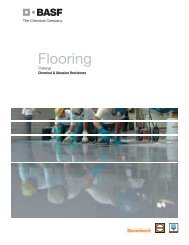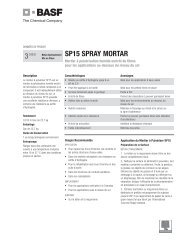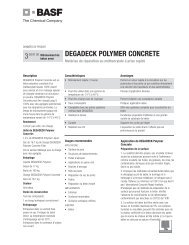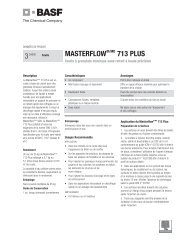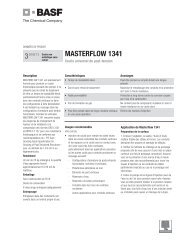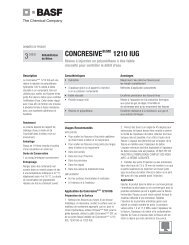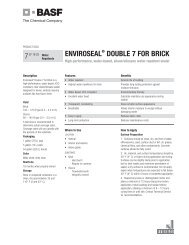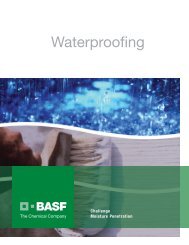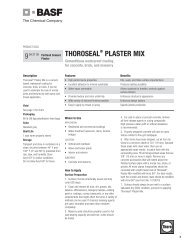SonogUarD® 7 - BASF Building Systems
SonogUarD® 7 - BASF Building Systems
SonogUarD® 7 - BASF Building Systems
You also want an ePaper? Increase the reach of your titles
YUMPU automatically turns print PDFs into web optimized ePapers that Google loves.
How to apply<br />
Surface Preparation<br />
ConCrete<br />
1. Concrete must be fully cured (28 days), structurally<br />
sound, clean, and dry (aStm d 4263). all concrete<br />
surfaces (new and old) must be shotblasted to remove<br />
previous coatings, laitance, and all miscellaneous<br />
surface contamination and to provide profile for proper<br />
adhesion. abrasive shotblasting must occur after<br />
concrete repair has taken place. Acid-etching is not<br />
permitted. proper profile should be a minimum of iCri<br />
CSp-3 (approximately 80 – 100 grit sandpaper).<br />
2. repair voids and delaminated areas with BaSF<br />
Construction Chemicals branded cementitious and<br />
epoxy patching materials. For application when fastturn<br />
around repairs are required, Conipur ® 265 can<br />
be used to repair patches up to 1” (25 mm) in depth.<br />
please refer to technical Service for proper application<br />
techniques.<br />
SurFaCe pre-Striping and detaiLing<br />
1. For nonmoving joints and cracks less than 1/16”<br />
(1.6 mm) wide, apply primer when required, followed<br />
by 25 wet mils (0.6 mm) prestriping of Base Coat.<br />
the Base Coat must be applied to fill and overlap the<br />
joint or crack 3” (76 mm) on each side. Feather the<br />
edges.<br />
Test Data, cont.<br />
Light to heaVy duty extra heaVy<br />
med traFFiC (reFuSaL duty<br />
& pedeStrian method) (reFuSaL method)<br />
Base coat<br />
Wet mils (mm) 25 (0.6) 25 (0.6) 25 (0.6)<br />
dry mils (mm) 20 (0.5) 20 (0.5) 20 (0.5)<br />
Coverage 1 60 (1.5) 60 (1.5) 60 (1.5)<br />
Mid coat<br />
Wet mils (mm) None 20 (0.5) 25 (0.6)<br />
dry mils (mm) none 15 (0.4) 20 (0.5)<br />
Coverage 1 none 80 (2.0) 60 (1.5)<br />
Finish coat<br />
Wet mils (mm) 25 (0.6) 20 (0.5) 20 (0.5)<br />
dry mils (mm) 20 (0.5) 15 (0.4) 15 (0.4)<br />
Coverage 1 60 (1.5) 80 (2.0) 80 (2.0)<br />
aggregate 2<br />
lbs per 100 ft 2 10 – 15 30 – 50 50 – 70<br />
(kg/m 2 ) (0.5 – 0.7) (1.5 – 2.5) (2.5 – 3.4)<br />
Coverage rates are approximate and may vary due to the application technique used.<br />
actual coverage rate will also depend on finish and porosity of the substrate.<br />
1 2 2 Coverage is ft /gal (m /L)<br />
2 (16 – 30 mesh rounded silica sand or proportional equivalent)<br />
2. Dynamic cracks and joints 1/16” (1.6 mm) and<br />
greater wide must be routed to a minimum of 1/4 by<br />
1/4” (6 by 6 mm) and cleaned. Install bondbreaker<br />
tape to prevent adhesion of sealants to the bottom of<br />
joint. prime joint faces only with Sonneborn ® primer<br />
733 (see Form no. 1017962). Fill joints deeper<br />
than 1/4” (6 mm) with appropriate backer-rod and<br />
SL 1 /SL 2 (slope grade or self-leveling) or<br />
np 1 /NP 1 sealants (see Form nos. 1017903 and<br />
1017911). For cracks, sealant should be flush with<br />
the adjacent concrete surface. For expansion joints,<br />
sealant should be slightly concave.<br />
3. Sealed joints 1” (25 mm) or less can be coated<br />
over with Sonoguard ® . expansion joints exceeding<br />
1” (25 mm) wide should not be coated over with<br />
Sonoguard ® so that they can perform independently<br />
of the deck coating system.<br />
4. Cut a 1/4 by 1/4” (6 by 6 mm) keyway into<br />
the concrete where the coating system will be<br />
terminated if no wall, joint, or other appropriate<br />
break exists. Fill according to instructions on cracks<br />
and joints over 1/16” (1.6 mm) wide.<br />
5. Form a sealant cant into the corner at the junction<br />
of all horizontal and vertical surfaces (wall sections,<br />
curbs, columns). prime with primer 733 and apply<br />
a 1/2 – 1” (13 – 25 mm) wide bead of NP 1 or<br />
np 2 sealants. tool to form a 45° cant.<br />
SonneBorn ® produCt data<br />
SonogUarD ®<br />
6. in locations of potential high movement, such as<br />
wall and slab intersections, apply 25 wet mils<br />
(0.6 mm) of Sonoguard ® Base Coat and embed<br />
Sonoshield ® reinforcing Fabric.<br />
metaL SurFaCeS<br />
1. remove dust, debris, and any other contaminants<br />
from vent, drain-pipe, and post penetrations; reglets;<br />
and other metal surfaces.<br />
2. Clean these surfaces to bright metal and prime<br />
immediately with primer 733.<br />
3. provide appropriate cant with np 1 , np 2 , or<br />
ultra sealant to eliminate 90° angles.<br />
PLyWOOD<br />
1. all plywood must be smooth-faced, apastamped,<br />
and exterior grade. Construction must<br />
conform to code, but plywood must not be less than<br />
15/32” (12 mm) thick. Plywood spacing and deck<br />
construction must follow apa guidelines.<br />
2. Surfaces must be free of contaminants. priming<br />
is not necessary on clean, dry plywood.<br />
3. All seams must be caulked with NP 1 or np 2 sealants (see Form nos. 1017906 and 1017911).<br />
prestripe 4 – 6” (102 – 152 mm) wide with 25 wet<br />
mils (0.6 mm) of Base Coat. reinforce all seams<br />
between plywood sheets and between flashing<br />
and the plywood deck by embedding Sonoshield ®<br />
reinforcing Fabric into the prestriping.<br />
20.3



